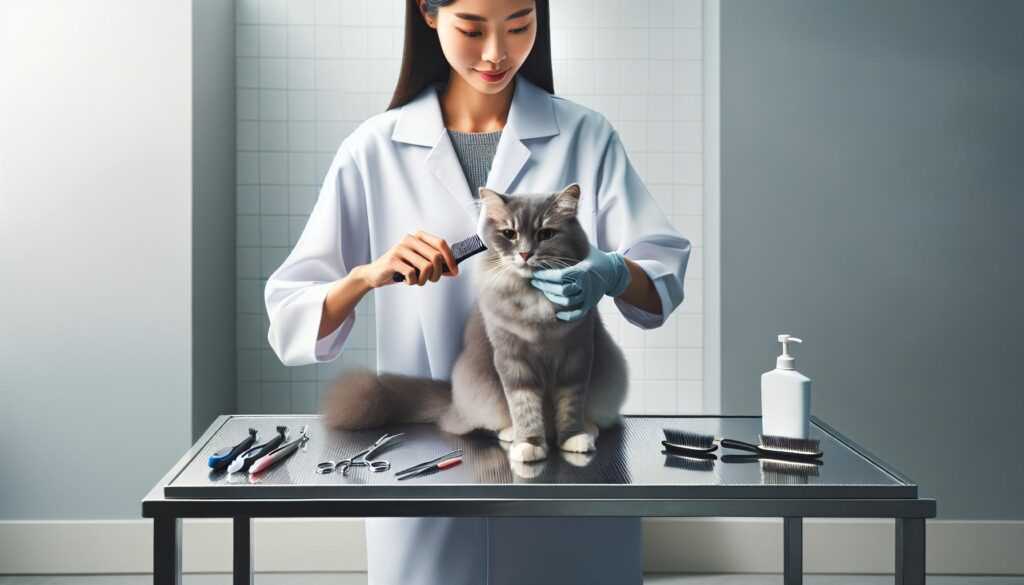
What is cat lymphoma?
When you’re exploring chemotherapy for your cat, understanding feline lymphoma is crucial. This term refers to a type of cancer that affects the lymphocytes, a form of white blood cell, in your cat’s body. Lymphocytes play a vital role in the immune system, making this condition directly impactful on your cat’s health. Feline lymphoma is not a single disease but rather a category that encompasses various forms of lymphatic cancer, each with its unique characteristics and treatment responses.
The disease is most commonly diagnosed in cats between the ages of 9 and 13, but it can appear at any age. There are several types of feline lymphoma, including:
- Alimentary lymphoma: This is the most common form, affecting the intestines. Symptoms often include vomiting, diarrhea, and weight loss.
- Mediastinal lymphoma: This form affects the chest area, leading to difficulties in breathing or swallowing.
- Multicentric lymphoma: Here, multiple lymph nodes throughout the body are affected.
Risk factors for developing feline lymphoma include exposure to carcinogens, certain viral infections such as the Feline Leukemia Virus (FeLV) and the Feline Immunodeficiency Virus (FIV), and genetic predisposition.
| Type of Lymphoma | Common Symptoms |
|---|---|
| Alimentary | Vomiting, Diarrhea, Weight Loss |
| Mediastinal | Breathing Difficulties, Swallowing Problems |
| Multicentric | Swollen Lymph Nodes |
Recognising the symptoms early and seeking veterinary advice is key to managing this condition. A diagnosis is typically made based on physical examination, blood tests, X-rays or ultrasounds, and definitive confirmation often requires a biopsy of affected tissues.
Armed with knowledge about feline lymphoma, you can better understand how chemotherapy might play a role in your cat’s treatment plan. The objective is to attack the cancerous cells while minimising discomfort and side effects for your furry friend.
Treatment options for feline lymphoma
When your beloved cat is diagnosed with lymphoma, understanding the available treatment options is crucial. Each method has its benefits and challenges, which you’ll need to consider carefully.
Chemotherapy for Feline Lymphoma
Chemotherapy is often the primary treatment for feline lymphoma. It involves the use of drugs to target and kill cancer cells, aiming to achieve remission and extend your cat’s life. The process is tailored to your pet’s specific needs, with considerations for the type of lymphoma, its progression, and how your cat responds to treatment.
- Types of Drugs: Various chemotherapy drugs are available, each with unique mechanisms of action.
- Treatment Regimens: Protocols can vary, ranging from weekly to monthly administrations.
- Side Effects: Generally mild in cats, including possible nausea and hair thinning. These are manageable and significantly less severe than in humans.
Veterinary oncologists play a critical role in this process, providing expertise and support throughout the treatment journey.
Surgery for Feline Lymphoma

In some cases, particularly with localized tumors, surgery can be an effective treatment for feline lymphoma. It involves the removal of the tumor and, if possible, some surrounding tissue to ensure no cancerous cells are left behind.
- Application: Best suited for solitary lesions that haven’t spread.
- Benefits: Immediate removal of cancerous growth.
- Considerations: Not all types of lymphoma are suitable for surgical intervention, and the procedure’s success largely depends on the lymphoma’s location and stage.
A thorough diagnostic evaluation is necessary to determine if your cat is a candidate for surgery, taking into account overall health and the lymphoma’s characteristics.
Radiotherapy for Feline Lymphoma
Radiotherapy, or radiation therapy, uses high-energy rays to target and destroy cancer cells in specific areas. It’s particularly useful for types of feline lymphoma that are localized and cannot be completely removed surgically.
- Application: Often used in combination with chemotherapy or surgery.
- Process: Involves multiple sessions over a set period.
- Side Effects: Can include localized hair loss and mild skin irritation, usually temporary and manageable.
Radiotherapy is a specialized treatment and may not be available in all veterinary practices. Consulting with a veterinary oncologist is essential to accessing this option and understanding its implications fully.
By exploring these treatment options for feline lymphoma, you’re taking an essential step towards providing your cat with the best possible care. Each approach offers hope and the potential for improved quality of life, making informed decisions crucial in this challenging time.
Understanding chemotherapy for feline lymphoma
When your beloved cat is diagnosed with lymphoma, understanding the available treatments is crucial. Among these, chemotherapy stands out as a common and effective method for managing this type of cancer in felines. Let’s delve deeper into how chemotherapy works, the drugs frequently used, and the potential side effects.
How does Chemotherapy Work?
Chemotherapy involves the use of drugs designed to kill or slow the growth of cancer cells. For cats with lymphoma, the goal is often to achieve remission, where the disease is not completely cured but its symptoms are significantly reduced or eliminated. Unlike humans, cats typically handle chemotherapy well and often continue to enjoy a good quality of life during treatment.
The process works by administering a combination of drugs over a set period. These drugs target rapidly dividing cells, a characteristic of cancer cells, but they can also affect healthy cells that grow quickly, which leads to some of the side effects associated with chemotherapy.
Commonly Used Chemotherapy Drugs
A variety of chemotherapy drugs are available for treating feline lymphoma. The choice of drugs and the regimen largely depend on the type of lymphoma, its stage, and the health of your cat. Below is a table highlighting some of the most commonly used chemotherapy drugs in the treatment of feline lymphoma:
| Drug Name | Use Case |
|---|---|
| Doxorubicin | Effective for a broad range of lymphoma types |
| Cyclophosphamide | Often used in combination with other drugs |
| Vincristine | Used for its effectiveness and limited side effects |
| Prednisolone | A steroid that can reduce inflammation and support immunity |
Each drug has its unique way of tackling cancer cells and is selected based on the most effective strategy for the individual cat’s condition.
Potential Side Effects of Chemotherapy
While cats generally tolerate chemotherapy better than humans, they can still experience side effects. These are usually mild and manageable but can include:
- Nausea and Vomiting: Anti-nausea medications can often control these symptoms.
- Low Blood Cell Counts: This condition can increase the risk of infection but is monitored closely by your vet.
- Loss of Appetite: Ensuring your cat has appealing food can help maintain their interest in eating.
- Hair Thinning: Less common than in humans, but can occur, particularly with certain drugs.
It’s vital to monitor your cat’s health closely and report any side effects to your vet, who can adjust the treatment plan as necessary to ensure your cat remains comfortable.
Benefits and risks of chemotherapy for feline lymphoma
When considering chemotherapy for your cat’s lymphoma, it’s crucial to weigh the benefits against the potential risks. Understanding these can help you make an informed decision alongside your vet.
Benefits:
- Extended Survival Time: Chemotherapy is known to prolong the life of cats suffering from lymphoma. Depending on the type and stage of lymphoma, remission is possible, allowing your cat to enjoy more quality time with you.
- Quality of Life: Unlike humans, cats typically handle chemotherapy well. The drugs used are carefully dosed to minimize discomfort, so many felines maintain a good quality of life during treatment.
- Tailored Treatments: Veterinarians can customize chemotherapy protocols based on your cat’s specific health needs, significantly enhancing the treatment’s effectiveness.
Risks:
- Side Effects: While generally well-tolerated, some cats may experience side effects such as nausea, lethargy, or hair loss. However, severe side effects are rare, and most can be managed with supportive care.
- Immunosuppression: Chemotherapy can weaken the immune system, leaving your cat more susceptible to infections. Regular monitoring by your vet can mitigate this risk.
Key Decision Points
Making the decision to go ahead with chemotherapy involves considering how the benefits outweigh the risks for your individual cat. It’s not just about extending life but ensuring the time left is comfortable and of high quality. Regular vet visits and open communication will be essential for adjusting the treatment plan as needed, always with your cat’s best interest at heart. Remember, every cat responds differently to chemotherapy, and what works for one may not work for another.
The chemotherapy process for feline lymphoma
When your beloved cat is diagnosed with lymphoma, understanding the process of chemotherapy can help you prepare for what’s ahead. Here’s a detailed look at each step of the treatment journey, from initial diagnostics to monitoring the response to chemotherapy.
Diagnostic Tests Before Starting Chemotherapy
Before your cat can begin chemotherapy, your vet will conduct a series of diagnostic tests to confirm the type of lymphoma and how far it has progressed. These tests are crucial for tailoring the chemotherapy plan to your cat’s specific needs. Common diagnostics include:
- Blood tests to evaluate overall health and organ function
- Biopsy to confirm the type of lymphoma
- Imaging tests (X-rays, ultrasound) to determine the stage of cancer
These tests provide valuable information that helps your vet choose the most effective chemotherapy drugs and regimen for your cat.
Creating a Chemotherapy Plan
Once the type and stage of lymphoma are confirmed, your vet will create a personalized chemotherapy plan. This plan is based on several factors, including:
- The type of lymphoma
- The stage of the disease
- Your cat’s overall health and medical history
Chemotherapy plans for feline lymphoma can vary widely, from single-agent chemotherapy to multi-drug protocols. Each plan aims to achieve the best possible outcome while minimizing side effects.
Administration of Chemotherapy Drugs
Chemotherapy drugs can be administered to cats in several ways, including:
- Intravenously (IV) – directly into a vein
- Orally – in pill or liquid form
- Subcutaneously (SC) – under the skin
- Intramuscularly (IM) – into a muscle
The method of administration depends on the specific drugs used in your cat’s chemotherapy plan. Some treatments may require a short stay at the vet clinic, while others can be given at home. Your vet will provide detailed instructions on how to administer these medications safely.
Monitoring the Response to Chemotherapy
Close monitoring of your cat’s response to chemotherapy is essential for adjusting the treatment plan as needed. This includes:
- Regular vet visits for physical exams and blood tests
- Watching for and reporting any side effects or changes in your cat’s behavior
Your vet will use these check-ups to assess how well the lymphoma is responding to treatment and to make any necessary adjustments. Monitoring your cat’s quality of life throughout chemotherapy is also crucial. This ensures that the benefits of treatment continue to outweigh any side effects.
Managing side effects during chemotherapy for feline lymphoma
Preparing for Potential Side Effects
When your cat undergoes chemotherapy for lymphoma, being prepared for potential side effects is crucial. Knowledge is your best tool. Understanding what might happen can help you provide the best care for your furry friend. Firstly, ensure you have a comfortable and quiet space at home where your cat can rest undisturbed. Stress can exacerbate side effects, so a calm environment is key. Additionally, keeping a close eye on your cat’s eating and drinking habits becomes more important than ever. Dehydration and weight loss can occur, so having fresh water and appetising, easily digestible foods available can help mitigate these risks. It’s also wise to have a list of emergency contacts ready, including your vet’s number and the nearest veterinary emergency clinic. Being prepared means you can act quickly should any serious side effects arise.
Common Side Effects and Their Management
Chemotherapy can produce a range of side effects in felines, but not all cats will experience them to the same extent. The most common include:
- Nausea and Vomiting: These are often the first signs of discomfort. Providing small, frequent meals and discussing anti-nausea medication with your vet can help manage these symptoms.
- Diarrhoea: Ensure your cat stays hydrated. Ask your vet about electrolyte supplements and easily digestible diets that can support recovery.
- Lethargy: Temporary decreases in energy are normal. Ensure your cat has a quiet, comfortable place to rest.
- Low White Blood Cell Count: This can increase infection risk. Minimize exposure to potential infection sources and monitor closely for signs of fever or illness.
- Hair loss: Though less common in cats than in humans or dogs undergoing chemotherapy, some thinning might occur. It’s more about aesthetics and does not bother most cats.
Management of these side effects often involves a combination of at-home care strategies and veterinary-prescribed medication. Regular check-ups will allow your vet to adjust the treatment plan as needed, ensuring your cat’s comfort and safety throughout the chemotherapy process. Keeping a detailed diary of your cat’s behaviour, appetite, and any side effects observed can be invaluable during these visits. This ongoing monitoring plays a critical role in the successful management of side effects and in making informed decisions regarding the continuation of chemotherapy.
Determining the success of chemotherapy for feline lymphoma
Assessing Response to Treatment
Evaluating the effectiveness of chemotherapy in cats diagnosed with lymphoma involves a series of steps. You’ll need to work closely with your vet to monitor your cat’s response to the treatment. Regular check-ups are vital and may include physical examinations, blood tests, and imaging studies such as X-rays or ultrasounds. These assessments help measure the size of the lymph nodes and the presence of lymphoma cells in the body.
Improvement signs include a reduction in lymph node size, increased energy levels, and better appetite. However, it’s crucial to remember that each cat’s response to chemotherapy is unique. Some may show rapid improvements, whereas others might require adjustments to their treatment plan before positive changes occur. Tracking your cat’s progress through these assessments will guide the ongoing approach to their chemotherapy.
Adjusting the Chemotherapy Plan as Needed
Based on the assessments, your vet may recommend changes to the chemotherapy plan. Adjustments are common and can be necessary for various reasons, including:
- Lack of sufficient response to the current drugs
- Emergence of side effects that impact the cat’s quality of life
- Changes in the cat’s overall health that affect treatment tolerance
Adjusting the treatment plan might entail changing the type of chemotherapy drug, altering the dosage, or modifying the frequency of administration. The goal is to find the most effective and least distressing regimen for your cat, ensuring that the benefits of chemotherapy outweigh the potential side effects. Such adjustments are a normal part of the process and are made with your cat’s best interests in mind.
Remember, ongoing communication with your vet is key to navigating through the chemotherapy journey. Keep a close eye on your pet’s behaviour, eating habits, and general well-being, and report any changes promptly. This proactive approach will help in making informed decisions that enhance the success of chemotherapy in managing feline lymphoma.
Other considerations for chemotherapy in feline lymphoma
When exploring chemotherapy for your cat’s lymphoma, it’s crucial to weigh various factors beyond the immediate treatment response. Understanding the full spectrum, from costs involved to quality of life and exploring alternatives, ensures you’re making an informed decision for your furry friend.
Cost of Chemotherapy
Chemotherapy for feline lymphoma can be a significant financial commitment. The total cost varies widely depending on the type and duration of treatment required. It’s important to have a clear conversation with your vet about the expected costs upfront. Here are a few factors that can influence the price:
- Type of Drugs: Some chemotherapy drugs are more expensive than others.
- Length of Treatment: Longer treatment plans increase costs.
- Frequency of Visits: Regular check-ups and monitoring can add up.
- Additional Care: Sometimes, cats may need supportive care like anti-nausea medication which incurs extra fees.
Budgeting for chemotherapy requires considering all these factors. Some insurance plans may cover part of the cost, so it’s worth checking your policy details.
Quality of Life During Chemotherapy
Your cat’s quality of life during chemotherapy is paramount. The good news is that cats tend to tolerate chemotherapy better than humans, often with fewer side effects. However, each cat’s reaction is unique. Here’s what you can monitor to ensure they remain comfortable:
- Appetite: Is your cat eating well?
- Energy Levels: Are they as active as usual?
- Mood: Is your cat’s behavior normal or are they showing signs of distress?
Adjustments to the chemotherapy protocol can often manage side effects effectively, so it’s vital to keep your vet informed about any changes in your cat’s condition.
Alternative Treatment Options
Chemotherapy is a common treatment for feline lymphoma, but it’s not the only option. Depending on your cat’s situation, you might consider exploring alternatives:
- Surgery: In cases where lymphoma is localized, surgical removal of the tumor may be possible.
- Radiation Therapy: This can be an option for certain types of lymphoma, often in combination with chemotherapy.
- Immunotherapy: A newer area of cancer treatment focusing on enhancing the immune system’s ability to fight cancer.
- Supportive Care: Focusing on providing comfort without aggressive treatment.
Each alternative comes with its own set of considerations regarding effectiveness, side effects, and costs. In-depth discussions with your veterinarian can help you understand these options in the context of your cat’s specific condition.
Conclusion
Navigating the journey of chemotherapy for your cat’s lymphoma can be challenging but knowing how to monitor the treatment’s effectiveness is key. Remember, it’s all about observing changes and staying in tune with your cat’s health. Adjustments to the chemotherapy plan are not uncommon and are aimed at ensuring your furry friend gets the best possible care. Your role in maintaining open lines of communication with your vet cannot be overstressed. It’s what makes the difference in managing your cat’s condition effectively. As you weigh the options, consider the balance between treatment costs and quality of life. Ultimately, the decisions you make will be guided by love and the desire for your cat to have a comfortable life.
FAQs
How can the success of chemotherapy for feline lymphoma be determined?
The success of chemotherapy for feline lymphoma is gauged through regular vet check-ups, physical exams, blood tests, and imaging studies. Signs of responding positively to the treatment include the reduction in size of lymph nodes, improvement in energy levels, and better appetite in the cat.
What steps are taken if a cat does not respond well to the initial chemotherapy plan?
If a cat doesn’t respond well to the initial chemotherapy, the plan may be adjusted. This can include changing the chemotherapy drug, altering the dosage, or modifying the frequency of administration to find a more effective and less distressing regimen.
Why is ongoing communication with the vet important during chemotherapy?
Ongoing communication with the vet is crucial as it allows for timely adjustments to the chemotherapy regimen based on the cat’s response to treatment. Reporting any changes promptly also helps in managing the condition more effectively and enhancing the success rate of the chemotherapy.
What are other treatment options for feline lymphoma apart from chemotherapy?
Besides chemotherapy, other treatment options for feline lymphoma include surgery, radiation therapy, immunotherapy, and supportive care. It’s vital to discuss these alternatives with the vet to make informed decisions based on the cat’s specific condition and overall well-being.
How should a cat owner consider the cost and quality of life during chemotherapy?
Cat owners should openly discuss the costs of chemotherapy with their vet, along with the expected quality of life for their pet during treatment. This involves weighing the benefits of extending life against potential side effects and distress, to make a decision that prioritizes the cat’s comfort and well-being.



